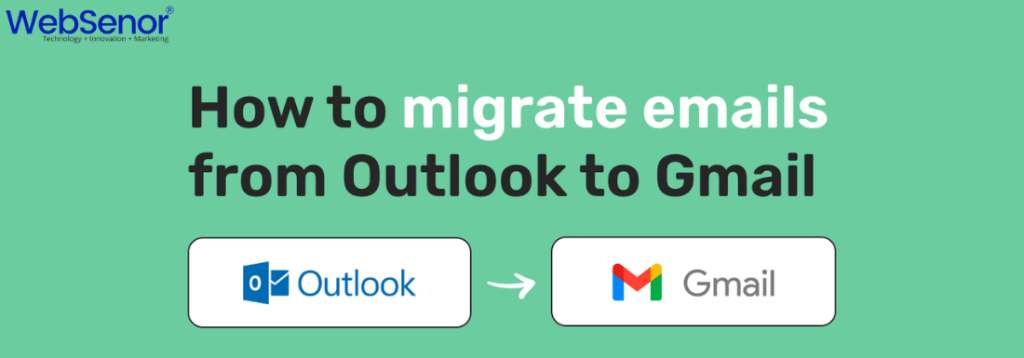In today’s digital world, email is a critical communication tool for both individuals and businesses. As cloud-based services continue to grow in popularity, many organizations are moving away from traditional on-premise email solutions like Microsoft Outlook to cloud-based solutions like Google Workspace (formerly G Suite). The process of migrating emails from Microsoft to Google can be daunting, but with the right approach and tools, it can be done seamlessly. This blog will guide you through the entire process of migrating emails and data from Microsoft to Google, including how to transfer Microsoft email to Gmail, migrate Outlook email to Google Workspace, and transfer data from Microsoft to Google.

Why Migrate Emails from Microsoft to Google?
Migrating emails from Microsoft to Google offers several advantages. Google Workspace provides a robust and flexible platform that integrates Gmail with other Google services like Google Drive, Google Calendar, and Google Meet. Here are some of the key benefits of moving to Google:
- Enhanced Collaboration: Google Workspace allows for real-time collaboration through Google Docs, Sheets, and Slides. Multiple users can work on the same document simultaneously, making teamwork more efficient.
- Accessibility: Gmail is accessible from any device with an internet connection, making it easier for users to check emails on the go.
- Storage and Organization: Google offers generous storage options and advanced search capabilities, helping users keep their inbox organized.
- Security: Google’s security features, such as two-factor authentication and phishing detection, provide robust protection against cyber threats.
- Cost-Effectiveness: Google Workspace often proves to be more cost-effective than traditional Microsoft Exchange setups, especially for small to medium-sized businesses.
Understanding the Migration Process
Before diving into the actual steps, it’s crucial to understand the migration process. The migration involves several stages, including preparation, data transfer, and post-migration validation. Here’s a breakdown of the process:
- Preparation:
- Assess the current email environment.
- Decide which data to migrate (emails, contacts, calendars).
- Inform users about the migration plan.
- Backup existing data.
- Data Transfer:
- Use built-in tools or third-party services to transfer data.
- Monitor the migration process for any errors or issues.
- Post-Migration:
- Verify that all data has been migrated correctly.
- Update DNS records if necessary.
- Provide training to users on the new system.
Migrate Emails from Microsoft to Google
The migration process can vary depending on the size of the organization and the tools available. Here, we will discuss both manual and automated methods.
Manual Migration Process
If you are migrating a small number of emails, a manual migration might be sufficient. Here’s how to do it:
- Export Emails from Microsoft Outlook:
- Open Outlook and go to
File > Open & Export > Import/Export. - Choose
Export to a fileand selectOutlook Data File (.pst). - Select the email folder you want to export and choose the destination for the file.
- Open Outlook and go to
- Import Emails into Gmail:
- Open Gmail and go to
Settings > Accounts and Import > Import mail and contacts. - Enter your Outlook email address and follow the prompts to import your emails.
- Open Gmail and go to
Using Third-Party Tools
For larger organizations, using third-party tools might be more efficient. Tools like MigrationWiz or CloudM automate the process and allow you to transfer large volumes of data quickly.
Transfer Microsoft Email to Gmail
If you are only looking to transfer your Microsoft email to Gmail, you can use Google’s data migration service or configure Gmail to retrieve emails from your Outlook account.
IMAP/POP Configuration
You can configure Gmail to fetch emails from your Microsoft Outlook account using IMAP or POP. Here’s how:
- Enable IMAP/POP in Outlook:
- Go to
File > Account Settings > Account Settings. - Select your email account and click
Change. - Under
Server Settings, chooseIMAPorPOP3.
- Go to
- Set Up Gmail:
- Open Gmail and go to
Settings > Accounts and Import > Add a mail account. - Enter your Outlook email address and configure the settings to use IMAP/POP.
- Open Gmail and go to
Using Google’s Data Migration Service
Google offers a data migration service that simplifies the process of transferring emails from Microsoft to Gmail. Here’s how to use it:
- Access the Data Migration Service:
- Log in to your Google Workspace admin console.
- Go to
Data Migration > Setup Data Migration.
- Configure the Migration:
- Choose
Emailas the data type andMicrosoft ExchangeorIMAPas the source. - Enter the credentials for the Microsoft account and select the users to migrate.
- Choose
- Start the Migration:
- Review the settings and start the migration.
- Monitor the progress and verify the data once the migration is complete.
Migrate emails from Microsoft to Google Workspace or G-Suite
Migrating Outlook email to Google Workspace involves more complex steps, especially for large organizations. Here’s a step-by-step guide:
Google Workspace Admin Console
- Prepare the Google Workspace Account:
- Ensure that all users have been created in Google Workspace.
- Set up the necessary domain and email aliases.
- Configure Google Workspace Migration:
- Log in to the Google Workspace admin console and go to
Setup > Data Migration. - Choose
Emailas the migration type and selectMicrosoft ExchangeorIMAP.
- Log in to the Google Workspace admin console and go to
- Start the Migration:
- Enter the Microsoft admin credentials and select the users you want to migrate.
- Choose the data range and other settings (e.g., calendar events, contacts).
- Start the migration and monitor its progress.
Batch Migration
For large organizations, batch migration allows you to migrate users in stages, reducing the impact on day-to-day operations. This method also allows for testing before the full migration.
Transfer Data from Microsoft to Google
In addition to emails, you might need to transfer other data such as contacts, calendars, and files. Google Workspace provides several tools to make this process easier.
Migrating Contacts and Calendars
- Export Contacts and Calendars from Microsoft Outlook:
- Go to
File > Open & Export > Import/Export. - Choose
Export to a fileand select the desired data (contacts, calendars). - Save the exported file in a CSV format.
- Go to
- Import Contacts and Calendars into Google:
- Open Google Contacts and go to
More > Importto upload the CSV file. - Open Google Calendar, click on
Settings, and chooseImport & Exportto upload calendar events.
- Open Google Contacts and go to
Google Drive and OneDrive Integration
If your organization uses OneDrive for file storage, you can transfer files to Google Drive. Here’s how:
- Download Files from OneDrive:
- Log in to your OneDrive account and select the files you want to transfer.
- Download the selected files to your local computer.
- Upload Files to Google Drive:
- Open Google Drive and create the necessary folders.
- Drag and drop the files from your local computer to Google Drive.
Challenges and Solutions in Migration
Migrating data from Microsoft to Google is not without its challenges. Common issues include data loss, email formatting problems, and user adoption difficulties. Here are some solutions:
- Data Loss: Ensure that you have a complete backup of all data before starting the migration. Use reliable tools and monitor the migration process closely.
- Email Formatting: Some email formatting may not transfer correctly, especially if using different email clients. Test the migrated emails and address any formatting issues manually.
- User Adoption: Moving to a new email system can be challenging for users. Provide adequate training and support to help them adapt to Google Workspace.
Best Practices for a Smooth Migration
To ensure a successful migration, follow these best practices:
- Pre-Migration Checklist:
- Assess your current environment.
- Plan the migration timeline.
- Communicate with users and provide training.
- Post-Migration Validation:
- Verify that all data has been transferred correctly.
- Update any necessary settings (e.g., DNS records).
- Gather feedback from users and address any issues.
Conclusion
WebSenor specializes in seamless Migrate emails from Microsoft to Google Workspace or G-Suite, ensuring your data is transferred efficiently and securely. Our expert team handles every aspect of the migration process, minimizing downtime and disruptions to your business. By choosing WebSenor, you can confidently transition to Google’s powerful platform, benefiting from enhanced collaboration, security, and accessibility. Whether you’re a small business or a large enterprise, our tailored migration solutions ensure a smooth and successful move to Google Workspace. Trust WebSenor to make your email migration effortless and efficient.







